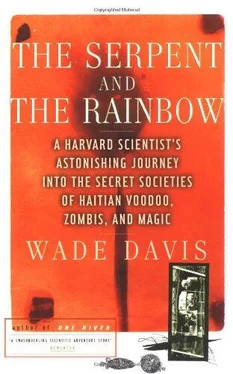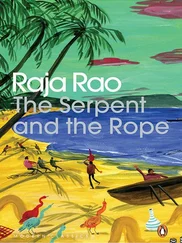Wade Davis - The Serpent and the Rainbow
Здесь есть возможность читать онлайн «Wade Davis - The Serpent and the Rainbow» весь текст электронной книги совершенно бесплатно (целиком полную версию без сокращений). В некоторых случаях можно слушать аудио, скачать через торрент в формате fb2 и присутствует краткое содержание. Год выпуска: 1985, Издательство: Simon & Schuster, Жанр: Старинная литература, на английском языке. Описание произведения, (предисловие) а так же отзывы посетителей доступны на портале библиотеки ЛибКат.
- Название:The Serpent and the Rainbow
- Автор:
- Издательство:Simon & Schuster
- Жанр:
- Год:1985
- ISBN:нет данных
- Рейтинг книги:5 / 5. Голосов: 1
-
Избранное:Добавить в избранное
- Отзывы:
-
Ваша оценка:
- 100
- 1
- 2
- 3
- 4
- 5
The Serpent and the Rainbow: краткое содержание, описание и аннотация
Предлагаем к чтению аннотацию, описание, краткое содержание или предисловие (зависит от того, что написал сам автор книги «The Serpent and the Rainbow»). Если вы не нашли необходимую информацию о книге — напишите в комментариях, мы постараемся отыскать её.
The Serpent and the Rainbow — читать онлайн бесплатно полную книгу (весь текст) целиком
Ниже представлен текст книги, разбитый по страницам. Система сохранения места последней прочитанной страницы, позволяет с удобством читать онлайн бесплатно книгу «The Serpent and the Rainbow», без необходимости каждый раз заново искать на чём Вы остановились. Поставьте закладку, и сможете в любой момент перейти на страницу, на которой закончили чтение.
Интервал:
Закладка:
Interpreting this new information made clearer what a vodounist considers to be a poison. Kline, the BBC, and others had obviously taken reports of an antidote too literally, assuming that it had to be a substance used to resurrect the zombi from apparent death. Such straightforward cause and effect, which I had tried to answer with the Calabar hypothesis, had seemed reasonable. It was logical and linear—just what the Haitian spirit realm is not. Out of curiosity I asked Marcel to name the greatest poison. There was no doubt, he replied, that far more deadly than the preparation we had made, more dangerous than even human remains, was a simple lime, properly prepared by the bokor. According to Marcel, and many other houngan I later asked, if a bokor cuts a lime transversely while it is still on the tree, the half that remains on the limb overnight becomes the most virulent of poisons. The other half taken into the temple becomes its equally potent antidote. The lesson was clear. The lime that is left on the tree remains in the realm of nature—uncivilized, threatening, poisonous. The other half, taken into the abode of the religious sanctuary, is tamed and humanized, and thus becomes profoundly curative. Apparently just as man himself has an ambivalent potential for good or evil, so do objects; in the case of the lime it is the intervention of man alone that may release its latent promise. For the vodounist there seem to be no absolutes. Only the houngan embodies all the cosmic forces and maintains their balance. So it was man who ruled the Haitian worldview, and it was the power of man that treated the poison victim. Similarly, I concluded, it would be man and not a poison that created a zombi.
Having tracked down the poison and its supposed antidote, I had very little time left before I was due back in Cambridge. But in those last days a curious event took place. At the time it seemed significant.
One afternoon in Saint Marc Max Beauvoir and I were approached by two men in peculiar uniforms and flat hats like those worn by the U.S. Marines when they occupied Haiti in the early years of this century. The men were members of a paramilitary cavalry group from the town of Desdunnes in the Artibonite Valley. This reputedly placed them as descendants of the legendary highwaymen who, dressed in loincloths and brandishing swords that deflected bullets, terrorized the caravans during the French colonial era. Much later during the American occupation, many of the men of Desdunnes joined the cako , the resistance fighters who waged guerrilla war from sanctuaries deep in the mountains of northern Haiti. Belief still has it that the leader of the U.S. Marine command was zombified by the cako. Today the residents of Desdunnes remain among the most fiercely independent people of Haiti.
The two men had heard that Beauvoir had influence in the capital, and they wanted to know if he might be able to arrange for them to demonstrate their horsemanship for the president. They offered to put on a private demonstration for Beauvoir the following week in Desdunnes.
The day before I was scheduled to leave Haiti, Max Beauvoir, Rachel, and I arrived in Desdunnes, finding more than fifty mounted men waiting beside their commander’s house. By American standards the horses were small, but all appeared well trained, and the men put on an impressive display. At midmorning, as the horsemen broke off and gathered by the plaza to drink with us and the commander, I happened to mention that I enjoyed horses. The commander took that casual comment as a signal that I wanted to ride with his group. Within minutes I was atop an exhausted horse. The commander asked Beauvoir if they ought to lead the horse by the halter, but by then a couple of the men and I were trotting out of the plaza. Then, as they realized I could indeed ride, the men broke into a gallop, and those on foot began to shout, “Savandier.” At that point, as I would later learn, the commander turned to Beauvoir and said, “A man who rides like that was born on the savanna. So, my friend, you come to have a look at us, and you bring your own rider.” Then after a pause he went on, “Let’s have a look at him. We have a horse that doesn’t dance, but it does run.”
We tethered our horses, and after a few drinks the rhythm of the afternoon set in. We had been sitting for about an hour when two men returned with a fresh brown mare.
The town was by then in a frenzy. It was Easter, and the Rara bands had swarmed out of the temples to celebrate the end of Lent. Their processions wove through the streets, swirling past one another, invading gardens and homes, absorbing idlers and growing longer and longer tails of dancers. From a distance they could be taken as hallucinations, except for the music—a single four-note song. The bass line came from four long bamboo tubes. Tin cans transformed into trumpets and trombones created a glittering horn section; rubber hose transformed into tubas created another. Percussion in the hands of a Haitian is anything that knocks—two sticks, a hubcap, a hammer-and-leaf spring from a truck.
The bandleader was a malevolent jester, somewhat androgynous. The others in the lead looked like the Queen of Hearts, only more lascivious, in long satin dresses sporting lewd bustlines. All of them were men. Sweeping across the head of the procession was a menacing figure, wielding a sisal whip, flailing at the crowd. But it was a symbolic display, and no one was hurt. Nevertheless Rara remains somehow intimidating and subversive. It is an amazing sexual inversion and an extraordinary triumph of the spirit. No wonder that by political decree the bands are permanently forbidden from entering the major cities.
So, with a gallery of dusty-faced peasants interwoven by the brilliant, swirling colors of the Rara bands, I got onto the horse. Two men on foot released the halter, and four others on horseback led me out of the plaza to the main entrance of town. As our trot broke into a canter, two of the other horsemen fell back. Then we began to run, and I found myself with the remaining horseman in an unanticipated contest. His challenge thinly disguised, he led me on a wide circuit about town, past the thatched huts and across the crowded plazas. At one point when I veered onto the wrong trail, the horseman paused and turned back to me, laughing. Then, as I drew abreast again, he loosened his rein and let out a great howl. The race was on in earnest. Women grabbed their children or chased away the chickens, and the town’s main thoroughfare became a storm of dust. As we circled the mapou tree in the central plaza, my horse entered the lead. The peasants began to shout, “Blanc, blanc” as froth from the neck of my horse struck my face.
Although I crossed the line a few paces ahead of my companion, it clearly mattered less who won than that the race had actually taken place. With obvious delight the commander took my reins as I dismounted, then led me into the courtyard of his house. Surrounded by the rest of his horsemen, we posed for the local photographer. Finally he led me into the house to join the Beauvoirs for lunch.
Only later would Max Beauvoir tell me that the commander was a president of a secret society, that I was now considered a member of his horse troop, and that the meal had been prepared and served by three queens of the secret society.
That afternoon we left Desdunnes and continued north to an important ceremonial center in the Artibonite Valley. There, once again by chance, I came across an important clue, yet it was a discovery that, like so many made during this first phase of my investigation, only deepened the mystery. At dusk, in the fields behind this most sacred of sites, I stumbled upon an entire field of planted datura. The next day I left Haiti and returned to the United States.
Читать дальшеИнтервал:
Закладка:
Похожие книги на «The Serpent and the Rainbow»
Представляем Вашему вниманию похожие книги на «The Serpent and the Rainbow» списком для выбора. Мы отобрали схожую по названию и смыслу литературу в надежде предоставить читателям больше вариантов отыскать новые, интересные, ещё непрочитанные произведения.
Обсуждение, отзывы о книге «The Serpent and the Rainbow» и просто собственные мнения читателей. Оставьте ваши комментарии, напишите, что Вы думаете о произведении, его смысле или главных героях. Укажите что конкретно понравилось, а что нет, и почему Вы так считаете.












